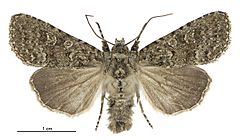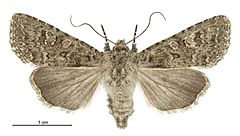Graphania omicron facts for kids
Quick facts for kids Graphania omicron |
|
|---|---|
 |
|
| Male | |
 |
|
| Female | |
| Scientific classification | |
| Kingdom: | |
| Phylum: | |
| Class: | |
| Order: | |
| Family: | |
| Genus: | |
| Species: |
G. omicron
|
| Binomial name | |
| Graphania omicron (Hudson, 1898)
|
|
| Synonyms | |
|
|
Graphania omicron is a special type of moth found only in New Zealand. It belongs to a group of moths called Noctuidae, which are often called owlet moths. This moth is considered "At Risk, Naturally Uncommon" by the New Zealand Department of Conservation. This means it's not very common in nature.
Contents
Discovering the Graphania omicron Moth
This moth was first described in 1898. A scientist named George Hudson gave it the name Melanchra omicron. It was found by Albert Norris in a place called Karori, near Wellington.
Later, in 1928, Hudson thought this moth was the same as another species. But in 1939, he realized they were different. So, Melanchra omicron became its own species again. In 2019, another scientist, Robert J. B. Hoare, studied New Zealand moths. He decided to place this moth in a different group, the Ichneutica genus.
What Does the Graphania omicron Moth Look Like?
This moth has a wingspan of about 1.5 inches (3.8 cm). Its front wings are a pale olive-green color. They have patterns and stripes of dull grey. You can see some faint lines across the wings. There are also black marks near the edges.
The moth has a large, round spot on its front wings. This spot is outlined in black. Its back wings are a brownish-grey color. They get darker towards the edges.
Where Does the Graphania omicron Moth Live?
This moth is endemic to New Zealand. This means it is found nowhere else in the world. It was first thought to only live in Wellington. However, some moths have been found in Otago as well.
Graphania omicron has been seen in places like Baring Head, Titahi Bay, and parts of Central Otago. It has also been found near the Otago Lakes.
Life and Habitat of the Moth
This moth can be seen flying during the months of November, December, and January. It has been found living in areas with raised shingle beaches. These are beaches made of small, smooth stones.
Conservation Status
The Graphania omicron moth is listed as "At Risk, Naturally Uncommon". This status is part of the New Zealand Threat Classification System. It means the moth is not very common in nature. It needs to be watched to make sure its population stays healthy.
Images for kids


